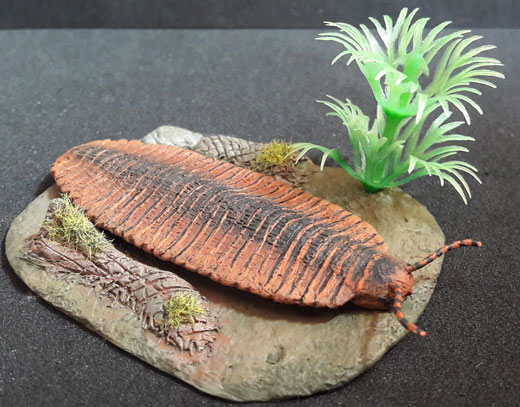Arthropleura Fossils Reveal the Face of a Giant Arthropod
Remarkable Arthropleura fossils from France offer new insights into the life and behaviour of one of the largest invertebrates known to science. For the first time, scientists have revealed the head of this giant arthropod in detail. Intriguingly, this study suggests that this Carboniferous creature had characteristics of both millipedes and centipedes. Arthropleura was a giant arthropod. For years, palaeontologists had only fragmentary body fossils to study. It was thought that it was a giant millipede, probably herbivorous, but the absence of any fossil material representing the head had meant that scientists could not be certain about its taxonomy.
The CT analysis of a fossil preserving the head surprised the research team. The head displays traits similar to early centipedes. This suggests that millipedes and centipedes may be more closely related than previously thought.

Arthropleura sp., specimen MNHN.F.SOT002123, details on the ventral sclerites and the feeding apparatus revealed by computer modelling after a CT scan of the fossil. Picture credit: Lhéritier et al.
Picture credit: Lhéritier et al
A Giant Invertebrate
Regarded as one of the largest land invertebrates of all time, some specimens may have measured over 2.6 metres in length. Arthropleura belongs to the arthropod group, which includes insects, crustaceans, and arachnids. It had been thought that it preferred damp, swampy environments. However, a study of fossil material published in 2021 indicated that larger individuals may have inhabited open woodland.
To read more about the giant invertebrate Arthropleura: Largest-ever Arthropleura Fossils Described.
The researchers, writing in the academic journal Science Advances, reveal breath-taking details identified from CT scans. The fossils do not represent fully grown individuals. However, they reveal important new details. Notably, the head morphology is similar to that of early centipedes.
One of the authors of the paper, Dr Greg Edgecombe from the London Natural History Museum explained how these fossils helped refine our understanding of Arthropleura. He explained that previously, the presence of two pairs of legs on each body segment indicated affinity with millipedes. Therefore, Arthropleura was thought to be a giant millipede. However, now that fossil material representing the head has been studied, this theory has been challenged. The head had enclosed mandibles and two pairs of head limbs behind them. These fossils challenge long held views on millipede and centipede taxonomy.
By combining data from hundreds of genes in living species with physical characteristics of fossils like Arthropleura, the situation was clarified. Millipedes and centipedes are actually each other’s closest relatives.
Studying Arthropleura Fossils
Many aspects of Arthropleura’s life remain a mystery, such as how it breathed and what it ate. Researchers are gradually forming a clearer picture of this invertebrate.
Living between 346 and 290 million years ago, Arthropleura was the largest land invertebrate during an era of giant arthropods. When these animals died, sediment quickly buried them. Some became encased in a mineral called siderite, forming nodules. These fossils preserved even the most delicate anatomical features, making them valuable for researchers.
After hundreds of millions of years of continental drift, some siderite nodules surfaced in a coal mine in Montceau-les-Mines, France, during the 1970s. They later went to the Museum of Autun, where CT scans are finally revealing their hidden contents.
In the past, these nodules would have been split open and casts taken to produce three-dimensional replicas of the fossils. However, the paper outlines how the Arthropleura fossils were scanned using a combination of microCT and synchrotron imagery to examine the Arthropleura inside, revealing the fine details of its anatomy.

A photograph of a latex cast taken from an Arthropleura fossil, the counterpart to specimen number MNHN.F.SOT002122. Picture credit: Lhéritier et al.
Picture credit: Lhéritier et al
Two Important Specimens
Two specimens were of particular significance to the researchers. These fossils represent juveniles. They measure just twenty-five and forty millimetres long, it is these fossils that reveal how Arthropleura reached a huge size.
Arthropleura specimens have different amounts of body segments. This suggests that these invertebrates added them until they reached a fixed maximum number. This is like most extant millipedes but differs from many centipedes, which are born with all of their segments already in place.
This means that Arthropleura’s maximum size would have been reached by, or after, sexual maturity, rather than at birth. The maximum size of the species used in the study is an open question, but it may not have been as massive as some of the biggest fossil specimens of Arthropleura spp. indicate.

It had been suggested that Arthropleura inhabited swampy environments. Whilst it was probably limited to equatorial regions, a recent study suggests it preferred open woodland. Picture credit: National Museum of Wales.
Picture credit: National Museum of Wales
Eyes on Stalks
Other aspects of their lifestyle are similarly ambiguous. While the researchers found that Arthropleura had club-shaped eyes, their structure has not survived. Moreover, startlingly, the Arthropleura fossils reveal that the eyes were on stalks. This is not a common feature in centipedes and millipedes. The team believe they were probably compound eyes, based on the animal’s relatives, but they cannot be certain.
No venom fangs or legs specialised for catching prey were found. Its legs are better adapted for slow movement. It is likely that Arthropleura was a detritus-eating animal, with a diet similar to modern day millipedes.
Everything Dinosaur acknowledges the assistance of the media team at the London Natural History Museum in the compilation of this article.
The scientific paper: “Head anatomy and phylogenomics show the Carboniferous giant Arthropleura belonged to a millipede-centipede group” by Mickaël Lhéritier, Gregory D. Edgecombe, Russell J. Garwood, Adrien Buisson, Alexis Gerbe, Nicolás Mongiardino Koch, Jean Vannier, Gilles Escarguel, Jérome Adrien, Vincent Fernandez, Aude Bergeret-Medina and Vincent Perrier published in Science Advances.
The Everything Dinosaur website: Prehistoric Animal Toys.


